Abstract
This study is focused on the effect of basalt fiber on the road performance of the asphalt mixture. The road performance of asphalt mixture with different dosages of basalt fiber was comprehensively evaluated using Marshall Stability test, the wheel tracking test, the three-point bending beam test and the freezing-thaw splitting test. The road performance of lignin fiber reinforced asphalt mixture and polyester fiber reinforced asphalt mixture also were tested to compare with the road performance of basalt fiber reinforced asphalt mixture. The results showed that basalt fiber can enhance mechanical properties, the low-and high-temperature performance and water sensitivity of the asphalt mixture significantly. Considering the road performance and economic benefits, the appropriate dosage of basalt fiber is about 0.3%. Marshall Stability (MS), dynamic stability (DS), the maximum bending strain and the tensile strength ratio (TSR) of asphalt mixture with 0.3% basalt fiber were increased by 19.6%, 25.5%, 22.2% and 6.0%, respectively. Basalt fiber has certain advantages in improving the low-temperature performance of asphalt mixture by comparison with lignin fiber and polyester fiber.
1. Introduction
With economic development, a large number of highways have been built in Jiangxi Province, China. Due to its advantages, like less expensive and wear-resisting, asphalt mixture is one the most commonly used building materials in the pavement construction of Jiangxi Province. However, because of the harsh climate and the increasing traffic volume, traditional asphalt mixtures are difficult to meet the durability requirement of asphalt pavement. Jiangxi Province is located in southern China and belongs to the humid subtropical climate zone. Permanent deformation of asphalt pavement, such as rutting, crowding, pushing and waves, are formed under heavy loads at high temperatures. In the rainy season, water damage, such as looseness, spalling, pits and pitted surfaces, are prone to appear. Meanwhile, in recent years, large-scale natural disasters, such as low temperatures, rain, snow and freezing, have also occurred in the Jiangxi Province. After severe natural disasters, large-area cracking of asphalt pavement appears which will reduce its life expectancy.
In order to improve the durability of asphalt pavement, many researchers add different types of fibers in the asphalt mixtures, such as lignin, polymer, polyester, mineral, rubber, carbon, rock, wool, plastic and so on [,,,]. Sheng et al. [] utilized both the polyester fiber and mineral fiber to enhance the performance of the SMA mixture. Putman et al. [] evaluated the permanent deformation and moisture susceptibility of asphalt mixture with waste fibers produced from scrap tire processing. Yooet al. [] proposed that a new type of plastic fiber can be used to improve structural integrity of the asphalt mixture. Guan et al. found that brucite fiber could increase the strength and toughness of asphalt mixture. Meanwhile, the addition of fibers also can prevent the degradation of asphalt during transportation and construction [,,]. C.Celauroet al. [] found the usability of basalt fibers in asphalt mixture has improved its resistance to permanent deformation. Chadbourn [] studied the high temperature property of asphalt mixture.Ahmad Muhammad et al. [,] discussed the water sensitivity and high-temperature performance of magnesium phosphate cement mortar with different dosages of basalt fiber by means of microscopic analysis. Aminul Haque, M. et al. demonstrated that the addition of three different fibrous materials can effectively improve the bending properties and compressive strength of the phosphate cement composites [,,]. Several studies have shown that the road performance of asphalt mixture can be enhanced by the addition of fibers [,,,]. However, different types of fibers have different performance improvements on asphalt mixtures.
Basalt fiber is produced from extremely fine fibers of basalt and hasexcellentphysical properties, high thermal stabilityand excellent chemical resistance [,]. As a new kind of high-performance fiber, basalt fibersalso areabundant in JiangxiProvince. However, it is usually used for structural, electrical technical purposes, such as electromagnetic shielding structures, aircraft, ships and household appliances, etc.In order to solve the problem of insufficient road durability in Jiangxi Province and promote the application of basalt fiber in pavement engineering, it is necessary to study the road performance of basalt fiber with a comprehensive evaluation.
In this article, the road performance of basalt fiber asphalt mixture was tested and comprehensively analyzed by the Marshall Stability test, the wheel tracking test, the three-point bending beam test and the freezing-thaw splitting test. The results show better performance with the optimum content of basalt fiber in the asphalt mixture. Besides, parallel contrast laboratory tests were studied between basalt fiber, polyester fiber and lignin fiber-reinforced asphalt mixture.
2. Materials and Methods
2.1. Materials
SBS-modified asphalt binder, which has been produced by the Guolin Petrochemical Industry (Xi’an, China), was used in all experiments. The indicators of the SBS-modified asphalt are given in Table 1. Basalt was selected as coarse aggregate and limestone were used for fine aggregate. The main technical indicators were shown in Table 2 and Table 3. The characteristics of limestone mineral filler were given in Table 4. Basalt fiber provided by Shi jin basalt Co., Ltd (Dongyang, China). Polyester fiber and lignin fiber were also chosen to make a comparison with basalt fiber. Polyester fiber and lignin fiber were obtained from Tie Cheng Co., Ltd (Xi’an, China). Their properties were shown in Table 5. Figure 1a presents the appearance of basalt fiber. Figure 1b shows the micrograph of basalt at 50 μm.As it is shown in Figure 1 that basalt fiber has a regular cylindrical shape with a diameter of about 11 to 13 μm.

Table 1.
SBS-modified asphalt test results and technical indicators.

Table 2.
Physical characteristics of the coarse aggregates.

Table 3.
Physical characteristics of fine aggregate.

Table 4.
Physical characteristics of mineral filler.

Table 5.
Main characteristics of basalt fiber, polyester fiber and lignin fiber.
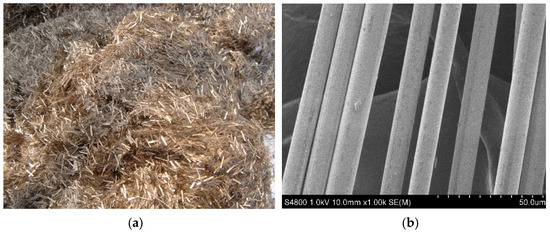
Figure 1.
Optical and scanning electron microscopy picture of basalt fiber: (a) appearance and (b) 1000 times.
2.2. Sample Preparation
The traditional AC-13 asphalt mixture is frequently used in the construction of asphalt pavement. In this study, the effect of basalt fiber on the performance of AC-13 was investigated. The gradation of the AC-13 asphalt mixture was given in Table 6 and Figure 2. The basalt fiber was added in the AC-13 asphalt mixture as an additive, and the proportions of basalt fiber in the AC-13asphalt mixture were 0%, 0.2%, 0.3%, 0.4% and 0.5% by weight. The optimum content of polyester fiber and lignin fibers in asphalt mixtures were 0.2% and 0.3%, which was provided by the manufacturer. In order to make the fibers dispersed evenly, basalt fiber asphalt mixture was prepared by the dry-mix method. At first, the fiber mixed with the aggregate in a rotary mixer for 90s to reduce the clumping or balling of fibers. Then, the asphalt and mineral filler were added, and the mixture was blended at 75 rpm for 180 s. The prepared mixture was placed in molds by the compaction method. Each sample extruded from the mold prior to the test after curing for 24 h.

Table 6.
Gradation of the asphalt mixture (AC-13).
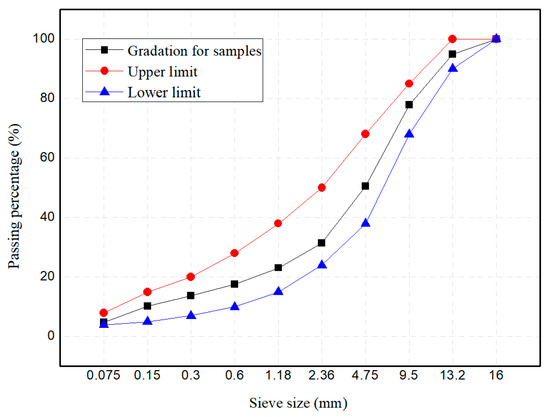
Figure 2.
Gradation of the AC-13 mixture.
2.3. Scanning Electron Microscopy (SEM) Analyses
The microstructure of basalt fibers and basalt fiber-reinforced asphalt mixtures were directly examined using a scanning electron microscope (SEM) device (Hitachi S-4800, Tokyo, Japan).At first, samples were dried in the drier for 10 h. Then, gold was sprayed on the surface of the sample. Finally, we put the sample into the sample stage for testing. The electron density in SEM was 105 A/cm2. The scanning voltage was 1.0 kV.
2.4. Marshall Design Test
According to the Marshall design method in Chinese standard JTG E20-2011 [] and asphalt adhesion-temperature curve, at the appropriate iso-viscous temperature, standard Marshall Specimens with 63.5mm±1.3mm in height and 101.6mm in diameter were molded by a Marshall compactor through double compaction 75 times. The number of specimens for a set was not less than 4. Then, the specimens were placed to cool at room temperature for 48h. The bulk specific gravity, air voids (VV), voids in the mineral aggregate (VMA), asphalt saturation (VFA), Marshall Stability (MS) and flow values (FL) of asphalt mixture with different dosages of basalt fiber were determined. According to that, the change curves of the Marshall physico-mechanical indexes with the asphalt contents were drawn. Finally, the optimum asphalt content (OAC) was determined.
2.5. Wheel Tracking Test
Wheel tracking test was used to measure the high temperature performance of basalt fiber-reinforced asphalt mixture in accordance with JTG E20-2011 []. Wheel tracking test was carried out using asize of 300 mm × 300 mm × 50 mm. After curing for 6 h at 60 °C in the testing chamber, a solid rubber tire moved backward and forward on the surface of the specimen. The moving length of the tire was 230 ± 10 mm.
The test load was applied at a constant load 0.7 MPa in the chamber, which temperature was controlled at 60 °C. The wheel was rolling with a velocity 42 cycles/min. The wheel tracking test evaluation index had dynamic stability. The dynamic stability was calculated using Formulation (1).
where was the dynamic stability of the mixture in cycles/mm, was the deformation corresponding to (45 min), was the deformation corresponding to (60 min) and was the type of test machine; in this paper, 1. was the specimen coefficient; in this paper, 1. as the rolling speed, 42 cycles/min.
2.6. Bending Test AtlowTemperature
The bending test at low temperature was measured using the MTS 810 material test systemin accordance with the Chinese standard JTG E20-2011 []. At least 5 prismatic specimens (30 mm × 35 mm × 250 mm) were used in the bending test at low temperature. After curing for 1h at −10 °C in a constant temperature bath, the specimen was tested with the three-point bending method and test temperature was controlled at −10 °C. The load was applied to the middle of the specimen with aspanlength of 200 mm at 50 mm/min. Five specimens per group were tested. The maximum bending strain was determined with Formulation (2).
where was the maximum bending strain; was the height of the cross-section, mm; was the span length, mm; was the mid-span deflection at the specimen failure, mm.
2.7. The Freezing-Thawing Splitting Test
The freezing-thawing splitting test was conducted to assessthewater stabilitybasalt fiber-reinforced asphalt mixturein accordance with the Chinese standard JTG E20-2011 []. The test temperature was maintained at 25 °C, with a loading rate of 50 mm/min. At first, the specimens were frozen at −18 °C for 16 h. Then, the frozen specimens were put in the tank, which was heated to 60 °C using the hot water for 24 h. After the freezing-thawing treatment, the specimens were immersed in water at a temperature of 25 °C for about 2 h. When the specimens were destroyed by the failing load, the tensile strength ratio (TSR) was determinedby Formulation (3)~(5). Five specimens per group were tested.
where TSR was the tensile strength ratio (%), RT1 was the average splitting strength without freeze-thaw (MPa) of the untreated sample, RT2 was the average splitting strength with freeze-thaw (MPa) of the conditional sample and PT1 was the maximum loads of the control groups (). PT2 was the maximum loads of the test groups ().
3. Results
3.1. Marshall Parameters
Figure 3 shows Marshall parameters of the asphalt mixture containing different dosages of basalt fiber, including the optimum asphalt content (OAC), the percent air voids in bituminous mixtures (VV), bulk specific gravity and Marshall stability.
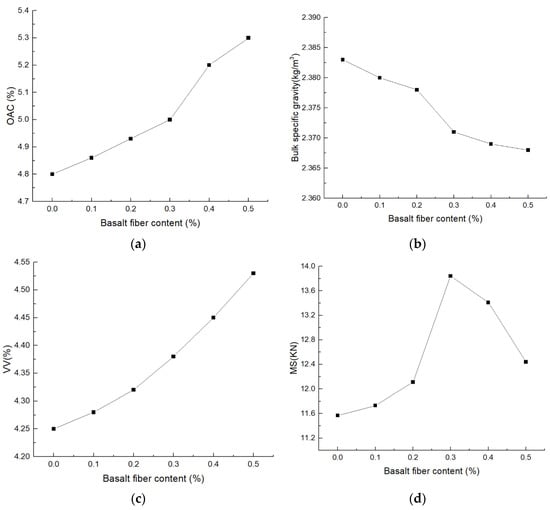
Figure 3.
Marshall parameters of asphalt mixture containing various dosages of basalt fiber (a) optimum asphalt content (OAC), (b) bulk-specific gravity, (c) air voids (VV) and (d) Marshall stability (MS).
Figure 3a displays the OAC of asphalt mixture containing different dosages ofbasalt fiber.When the dosage of basalt fiber in the asphalt mixture is 0.1%, 0.2%, 0.3%, 0.4% and 0.5%, the OAC of asphalt mixture is 4.87%,4.98%, 5.00%, 5.20% and 5.30%, respectively. As the basalt fiber dosage increases, the value of OAC increases significantly.Basalt fiber hasa large specific surface area, which results in absorbing more asphalt. Therefore, the OAC increases after adding the basalt fiber.
Figure 3b displays the bulk specific gravity of asphalt mixtures containing different dosages of basalt fiber. The values of the bulk-specific gravity were between 2.383 and 2.368.As the dosage of basalt fiber increases, the value of bulk-specific gravity decreases slightly. The basalt fiber density is small and occupies a certain space. For the same volume of specimens, the mass of the asphalt mixture with the fiber is lower, which results in the decrease of the bulk-specific gravity.
Figure 3c shows that the value of VV increases with the increase of basalt fiber dosage. When the dosage of basalt fiber reaches 0.5%, the value of VV increases by 4.53%.The basalt fiber was mixed in the mixture, the gross bulk density of the mixture decreased and the elastic modulus of the basalt fiber is large. Therefore, the structure of the mixture is not as dense as that of the ordinary asphalt mixture under the same compaction condition.
Figure 3d displays the value of Marshall Stability (MS) of asphalt mixtures containing various basalt fiber dosages. As the amount of basalt fiber dosage increases, the value of MS increases first and then decreases. The reason may be that excessive fiber dosage leads to uneven fiber dispersion in asphalt mixture. These defects inside the mixture will lead to a decrease of MS. When the fiber dosage was 0.3%, the maximum MS value was obtained. Compare with the control sample, the MS value of asphalt mixture containing 0.3% basalt dosage was increased by 19.6%. Liu found that asphalt mixture with higher values of MS always have a better anti-crack resistance property [].
3.2. High-Temperature Stability
The results of dynamic stability (DS) of asphalt mixture containing various dosages of basalt fiber were given in Figure 4. As the dosage of basalt fiber increases, the value of DS increases first and then decreases. Figure 4 shows that when the dosage of basalt fiber is 0.3%, the DS reaches the maximum value 5568 times/mm. The value of DS of asphalt mixture with 0.3% basalt dosage is 1.25 times that of the asphalt mixture without basalt fiber. Test results prove that the high-temperature property of mixtures can be enhanced significantly by the addition of basalt fiber. Basalt fiber can absorb the light components in asphalt and increase the viscosity of asphalt mortar. Therefore, the bonding strength between the asphalt and the aggregate was increased. Moreover, the bonding strength was also increased by the fiber bridging effect [].
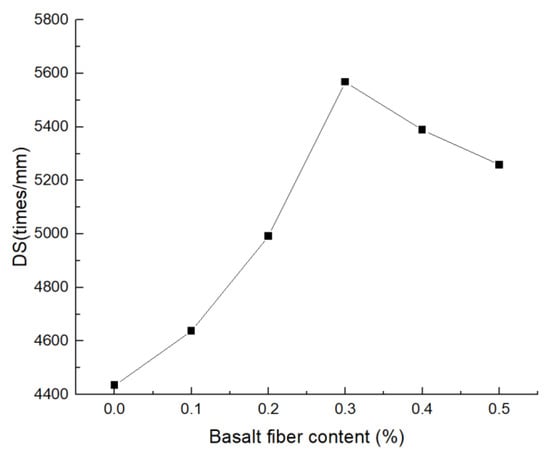
Figure 4.
Dynamic stability (DS) of asphalt mixture containing variousdosages of basalt fiber.
3.3. Low-Temperature Property
Figure 5 displays the maximum bending strain of the asphalt mixture containing different dosages of basalt fiber. As seen from Figure 5, the development of low-temperature property is similar to that of the high-temperature stability with the increase of basalt fiber dosages. When the dosage reaches 0.4%, failure strain reaches the maximum value. It is worth noting that the maximum bending strain of asphalt mixture containing 0.4% dosage of basalt fiber is only 2% higher than that of asphalt mixture containing 0.3% dosage of basalt fiber. The maximum bending strain of the asphalt mixture is increased by 24.8% when the dosage of basalt fiber reaches 0.4%.Test results prove that the low-temperature property of mixtures can be enhanced significantly by the addition of basalt fiber. Basalt fiber randomly dispersed in the three-dimensional spaces of the asphalt mixture. It can transfer and disperse stress and avoid concentrating stress excessively. Figure 6 shows the anti-cracking action in the asphalt mixture. Basalt fiber plays a “bridge” role, which also retarded the development of cracks.
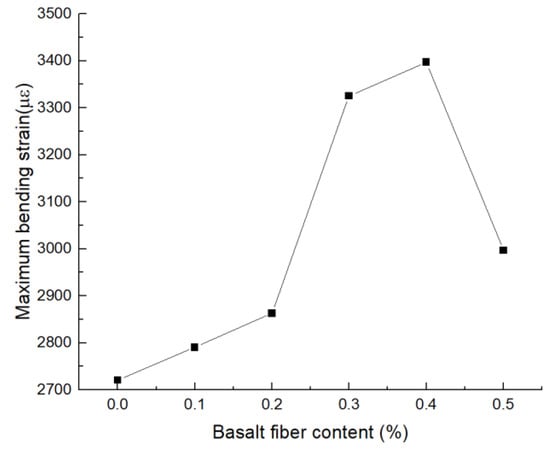
Figure 5.
The maximum bending strain of asphalt mixture containing various dosages of basalt fiber.
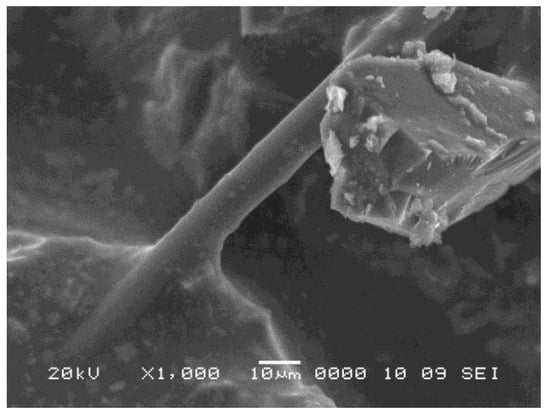
Figure 6.
SEM micrographs of basalt fiber-reinforced asphalt.
3.4. Water Sensitivity
Figure 7 shows the tensile strength ratio (TSR) of asphalt mixture containing various dosages of basalt fiber. When the dosage of basalt fiber is less than 0.4%, as the amount of basalt fiber increases, the value of TSR increases. When the basalt fiber dosage is 0.4%, the TSR reaches the maximum value. It indicated that the optimum dosage of basalt fiber for the water sensitivity of the asphalt mixture is 0.4%. In contrast with control sample, the value of TSR of asphalt mixture containing 0.4% basalt fiber is increased by 8.3%. The main reason for this phenomenon is that the surfaces of the basalt fiber and asphalt are alkaline and acidic, respectively. Additionally, the specific surface area of the fiber is relatively large. Basalt fiber absorbs the light components in asphalt and increases the thickness of asphalt film and improves the bonding strength between the asphalt and the aggregate, which is beneficial for preventing moisture from entering the interface between the asphalt and aggregate []. After the dosage of basalt fiber is more than 0.4%, the value of TSR is reduced greatly. The reason may be that excessive fiber dosage leads to uneven fiber dispersion and excessive porosity of the mixture, which reduces water stability of the asphalt mixture.
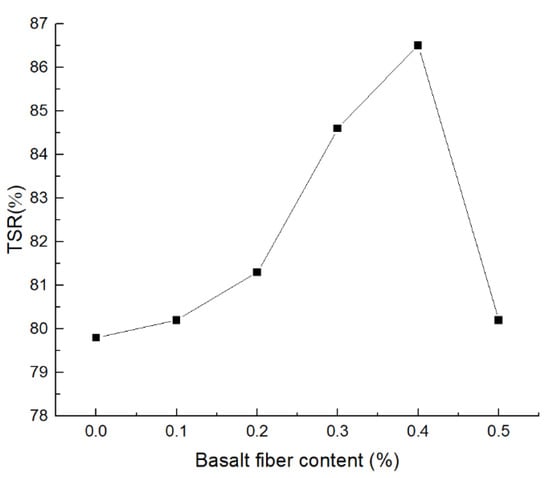
Figure 7.
Tensile strength ratio (TSR) of asphalt mixture containing various dosages of basalt fiber.
3.5. Compared with Different Fiber-Reinforced Asphalt Mixture
Figure 8 shows the test results of the Marshall Stability, high-temperature stability, low-temperature stability and water sensitivity of asphalt mixture containing a different type of fiber. The optimal dosage of each fiber was added in the asphalt mixture. According to the test results above, the optimum dosage of basalt fiber is about 0.3%. The optimum dosage of polyester fiber and lignin fibers are 0.4% and 0.35%, which were recommended by the manufacturer. In contrast with the control group, after adding basalt fiber, polyester fiber and lignin fiber, the MS of asphalt mixture increases by 19.6%, 14.5% and 6.8%, respectively. Figure 8a also shows that the value of MS of asphalt mixture containing basalt fiber is higher than the other fibers. Figure 8b shows that the value of DS of basalt fiber-reinforced asphalt mixture and the polyester fiber-reinforced asphalt mixture are higher than lignin fiber-reinforced asphalt mixture. It can be seen from Table 5 that basalt fiber and polyester fiber have better mechanical properties than lignin fiber, which is beneficial for improving the rutting resistance and the shear capacity of asphalt mixture. Figure 8c shows the maximum bending strength of asphalt mixtures containing different kinds of fibers. As can be seen from Figure 8c, the maximum bending strength of basalt fiber-reinforced asphalt mixture is higher than that of lignin fiber-reinforced asphalt mixture and polyester fiber-reinforced asphalt mixture. The basalt fiber with higher tensile strength crosses the crack faces and slows down the delimitation growthof asphalt mixture. This may be the reason why the basalt fiber asphalt mixture has better anti-cracking properties at low temperatures. Figure 8d shows the value of TSR of the asphalt mixture containing three kinds of fiber and the control sample. As seen in Figure 8d, the value of the asphalt mixture containing basalt fiber is lower than the asphalt mixture containing polyester fiber. However, it is higher than the asphalt mixture with lignin fiber and the control sample.
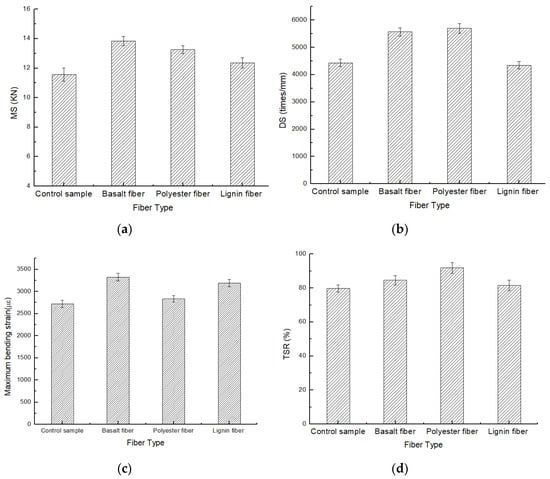
Figure 8.
The road performance of various kinds of fiber-reinforced asphalt mixtures: (a) MS, (b) DS, (c) maximum bending strain and (d) TSR.
4. Conclusions
- Basalt fiber-reinforced asphalt mixture is superior to the ordinary asphalt mixture in high-temperature stability, crack resistance at low temperatures and water sensitivity.
- Considering the road performance and economic benefits, the optimum dosage of basalt fiberisabout0.3%.MS, DS, the maximum bending strain and TSR of asphalt mixture with 0.3% basalt fiber are increased by 19.6%, 25.5%, 22.2% and 6.0%, respectively.
- By comparing the test results of lignin fiber and polyester fiber, basalt fiber has superiority in enhancing the low-temperature crack resistance of the asphalt mixture.
- Considering large-scale natural disasters, such as low temperatures, rain, snow and freezing, often occurring in recent years, higher requirements are placed on the crack resistance of asphalt mixtures. Basalt fiber is more suitable for pavement construction in Jiangxi Province.
Author Contributions
Conceptualization, H.Z.; methodology, B.G.; validation, H.Z., B.G. and R.X.; formal analysis, H.Z.; investigation, B.G.; resources, R.X.; data curation, H.Z.; writing—original draft preparation, H.Z.; writing—review and editing, H.Z.; visualization, A.Z.; supervision, A.Z.; project administration, H.Z. and funding acquisition, H.Z. All authors have read and agreed to the published version of the manuscript.
Funding
This research was funded by the Key R&D Plan of Jiangxi Provincial Department of Science and Technology (20192BBG70064), the program of China Scholarships Council (No.201906825007), the program of Traffic Innovation Management Consulting Research Project of Yunnan Province (No.2019304) and the China Postdoctoral Science Foundation (No.2019M653520).
Conflicts of Interest
The authors declare no conflicts of interest.
References
- Xue, Q.; Lei, L.; Yi-Jun, C. Study on the action effect of pavement straw composite fiber material in asphalt mixture. Constr. Build. Mater. 2013, 43, 293–299. [Google Scholar]
- Shanbara, H.; Ruddock, F.; Atherton, W. A laboratory study of high-performance cold mix asphalt mixtures reinforced with natural and synthetic fibres. Constr. Build. Mater. 2018, 172, 166–175. [Google Scholar] [CrossRef]
- Takaikaew, T.; Tepsriha, P.; Horpibulsuk, S.; Hoy, M.; Kaloush, K.; Arulrajah, A. Performance of Fiber-Reinforced Asphalt Concretes with Various Asphalt Binders in Thailand. J. Mater. Civ. Eng. 2018, 30, 04018193. [Google Scholar] [CrossRef]
- Cheng, Y.; Wang, W.; Gong, Y.; Wang, S.; Yang, S.; Sun, X. Comparative Study on the Damage Characteristics of Asphalt Mixtures Reinforced with an Eco-Friendly Basalt Fiber under Freeze-thaw Cycles. Materials 2018, 11, 2488. [Google Scholar] [CrossRef] [PubMed]
- Sheng, Y.; Li, H.; Guo, P.; Zhao, G.; Chen, H.; Xiong, R. Effect of Fibers on Mixture Design of Stone Matrix Asphalt. Appl. Sci. 2017, 7, 297. [Google Scholar] [CrossRef]
- Putman, B.J.; Amirkhanian, S. Utilization of waste fibers in stone matrix asphalt mixtures. Resour. Conserv. Recycl. 2004, 42, 265–274. [Google Scholar] [CrossRef]
- Yoo, P.J.; Ohm, B.S.; Choi, J.Y. Toughening characteristics of plastic fiber-reinforced hot-mix asphalt mixtures. KSCE J. Civ. Eng. 2012, 16, 751–758. [Google Scholar] [CrossRef]
- Hassan, H.F.; Al-Oraimi, S.; Taha, R.A. Evaluation of Open-Graded Friction Course Mixtures Containing Cellulose Fibers and Styrene Butadiene Rubber Polymer. J. Mater. Civ. Eng. 2005, 17, 416–422. [Google Scholar] [CrossRef]
- Association of Asphalt Paving. Journal of the Association of Asphalt Paving Technologists; Association of Asphalt Paving Technologists: White Bear Lake, MN, USA, 2006. [Google Scholar]
- Taki, A.; Firouzi, A.; Mohammadzadeh, S. Life cycle reliability assessment of reinforced concrete beams shear-strengthened with carbon fiber reinforced polymer strips in accordance withfibbulletin 14. Struct. Concr. 2018, 19, 2017–2028. [Google Scholar] [CrossRef]
- Celauro, C.; Pratico, F. Asphalt mixtures modified with basalt fibres for surface courses. Constr. Build. Mater. 2018, 170, 245–253. [Google Scholar] [CrossRef]
- Chadbourn, B.A.; Skok, E.L., Jr.; Newcomb, D.E.; Crow, B.L.; Spindle, S. The Effect of Voids in Mineral Aggregate (VMA) on Hot-Mix Asphalt Pavements, in Final Report 2000–2013; Minnesota Department of Transportation Office of Research Services: Minneapolis, MN, USA, 1999. [Google Scholar]
- Ahmad, M.R.; Chen, B. Microstructural characterization of basalt fiber reinforced magnesium phosphate cement supplemented by silica fume. Constr. Build. Mater. 2020, 237, 117795. [Google Scholar] [CrossRef]
- Ding, Y.; Zeng, W.; Wang, Q.; Zhang, Y. Topographical analysis of fractured surface roughness of macro fiber reinforced concrete and its correlation with flexural toughness. Constr. Build. Mater. 2020, 235, 117466. [Google Scholar] [CrossRef]
- Haque, M.A.; Chen, B.; Ahmad, M.R.; Shah, S.F.A. Mechanical strength and flexural parameters analysis of micro-steel, polyvinyl and basalt fibre reinforced magnesium phosphate cement mortars. Constr. Build. Mater. 2020, 235, 117447. [Google Scholar] [CrossRef]
- Shishevan, F.A.; Akbulut, H.; Mohtadi-Bonab, M.A. Erratum to: Low Velocity Impact Behavior of Basalt Fiber-Reinforced Polymer Composites. J. Mater. Eng. Perform. 2017, 26, 4155. [Google Scholar] [CrossRef]
- Guan, B.; Liu, J.; Zhao, H.; Wu, J.; Liu, J.; Yang, F. Investigation of the Microwave Absorption of Asphalt Mixtures Containing Magnetite Powder. Coatings 2019, 9, 813. [Google Scholar] [CrossRef]
- Guan, B.; Liu, J.; Wu, J.; Liu, J.; Tian, H.; Huang, T.; Liu, C.; Ren, T. Investigation of the Performance of the Ecofriendly Fiber-Reinforced Asphalt Mixture as a Sustainable Pavement Material. Adv. Mater. Sci. Eng. 2019, 2019, 1–11. [Google Scholar] [CrossRef]
- Liu, F.; Dong, A.; Liu, C.; Wu, W. Mix design of asphalt mixture used for the waterproof and anti-cracking layer in the rainy area of South China. J. Appl. Biomater. Funct. Mater. 2018, 16, 112–118. [Google Scholar] [CrossRef] [PubMed]
- Guan, B.; Xiong, R.; He, R.; Chen, S.; Ding, D. Investigation of Usability of Brucite Fiber in Asphalt Mixture. Int. J. Pavement Res. Technol. 2014, 7, 193–202. [Google Scholar]
- Fu, S.-Y.; Lauke, B.; Mader, E.; Yue, C.; Hu, X. Tensile properties of short-glass-fiber- and short-carbon-fiber-reinforced polypropylene composites. Compos. Part A: Appl. Sci. Manuf. 2000, 31, 1117–1125. [Google Scholar] [CrossRef]
- McDaniel, R.S. Asphalt Additives to Control Rutting and Cracking; Purdue University: West Lafayette, IN, USA, 2001. [Google Scholar]
- Transport, M.O. Standard Test Methods of Bitumen and Bituminous Mixtures for Highway Engineering; Ministry of Transport: Beijing, China, 2011.
© 2020 by the authors. Licensee MDPI, Basel, Switzerland. This article is an open access article distributed under the terms and conditions of the Creative Commons Attribution (CC BY) license (http://creativecommons.org/licenses/by/4.0/).